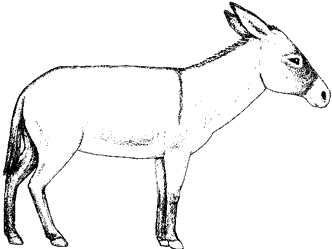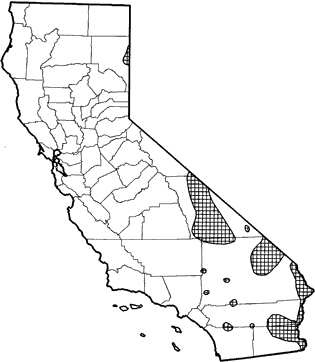
Feral Burro
Distribution, Abundance, and Seasonality
Uncommon to locally common in deserts of California. Range extends into eastern Lassen Co., and from extreme southern Mono Co. south to the Mexican border. Most are found in Inyo Co., northeastern San Bernardino Co., and in the vicinity of the Colorado River. Occur from below sea level to 2450 m (7800 ft). Habitats used include sagebrush, bitterbrush, alkali desert scrub, desert scrub, desert succulent shrub, desert riparian, desert wash, Joshua tree, pinyon-juniper, montane chaparral, and pasture (Moehlman 1974, Woodward and Ohmart 1976, Norment and Douglas 1977, Seegmiller and Ohmart 1981).

Range Map
Specific Habitat Requirements
Feeding: Feed on grasses, forbs, and browse (Moehlman 1974, Woodward and Ohmart 1976, Seegmiller and Ohmart 1981, National Academy of Sciences 1982). Eat a wide variety of plant species. Prefer grasses and forbs, but subsist in some areas primarily on browse.
Cover: Seek shade and cover in shrubs and riparian habitats in summer.
Reproduction: Probably use brush and riparian areas for cover during parturition.
Water: Water sources are critical during summer months, and activities become localized around water sources. Usually drink once a day in summer, although females with foals may drink 2-3 times per day.
Pattern: During summer, spend much time in riparian habitats and desert washes. Each day, move to surrounding scrub communities for morning feeding, returning to dense, shady riparian areas by mid-day. In fall and winter, disperse to open shrub habitats on sloping and rolling terrain. They avoid rocky habitats and steep slopes.
Species Life History
Activity Patterns: Active yearlong; primarily diurnal, with some nocturnal feeding and drinking in riparian areas and cultivated fields in summer.
Seasonal Movements / Migration: Move to riparian areas in summer.
Home Range: Home range size varies tremendously depending on season, age, sex, geographic location, and population density. Most studies report home ranges between 5-70 km? (2-22 mi?). Summer ranges are smaller than winter ranges.
Territory: Home ranges of males and females overlap. Males may be territorial, but such territories are solely for access to females; territories are not defended. Stable female groups do not form, unlike wild horses.
Reproduction: Mating occurs yearlong, but peaks from May-July. Gestation is about 12 mo, so there is a peak in births from May-July (Moehlman 1974). The precocial young reach sexual maturity as yearlings. One young is produced; often females produce young in alternate years. Several populations have been observed to have recruitment rates of 20-25%.
Niche: Have a substantial effect on desert and riparian vegetation (Douglas and Norment 1977, Seegmiller and Ohmart 1981, National Academy ol Sciences 1982). Native ungulates, in particular mountain sheep, are adversely affected by feeding activities. Also have a negative effect on mountain sheep because of their use of permanent water sources (Seegmiller and Ohmart 1981, Dunn and Douglas 1982). Recently, a program of removal has begun on public lands (Kovach 1982), with some indications of reoccupation of range by mountain sheep. All burro populations in the southwestern U.S. are feral; they originated from domestic stock.
Sources & References
California Department of Fish and Game, 1999.
California's Wildlife, Sacramento, CA.
Written by: R. A. Hopkins, reviewed by: H. Shellhammer, edited by: J. Harris, R. Duke
Douglas, C. L., and C. Norment. 1977. Habitat damage by feral burros in Death Valley. Desert Bighorn Counc. Trans. 21:23-25. Dunn, W. C., and C. L. Douglas. 1982. Interactions between desert bighorn sheep and feral burros at spring areas in Death Valley. Desert Bighorn Counc. Trans. 26:87-96. Ginnett, T. F., and C. L. Douglas. 1982. Food habits of feral burros and desert bighorn sheep in Death Valley National Monument. Desert Bighorn Counc. Trans. 26:81-87. Kovach, S. D. 1982. Report of the feral burro committee. Desert Bighorn Counc. Trans. 26:101-102. Moehlman, P. D. R. 1974. Behavior and ecology of feral asses (equus asinus). Ph.D. Diss. Univ. Wisc., Madison. 277pp. National Academy of Sciences. 1982. Wild and free-roaming horses and burros. Final Rep. National Academy Press, Washington, DC. 80pp. Norment, C., and C. L. Douglas. 1977. Ecological studies of feral burros in Death Valley. Coop. Nat. Park Res. Studies Unit, Univ. Nevada, Las Vegas. Contr. No. 17. 132pp. Seegmiller, R. F., and R. D. Ohmart. 1981. Ecological relationships of feral burros and desert bighorn sheep. Wildl. Monogr. No. 78. 58pp. White, L. D. 1980. A study of feral burros in Butte Valley, Death Valley National Monument. Univ. Nevada, Las Vegas, Coop. Nat. Park Resour. Studies Unit. Contr. No. 006/ 16. 124pp. Woodward, S. L., and R. D. Ohmart. 1976. Habitat use and fecal analysis of feral burros (Equus asinus), Chemehuevi Mountains, California, 1974. J. Range Manage. 29:482-485.
California Animal Facts | California's Wildlife